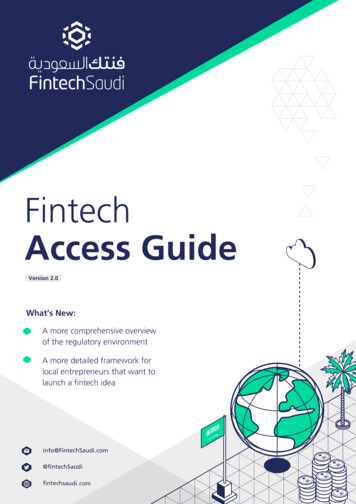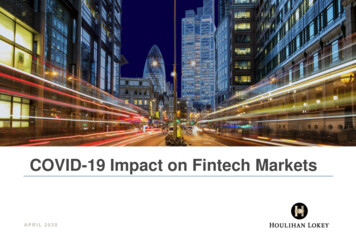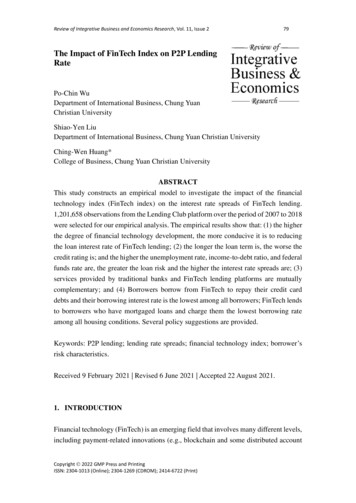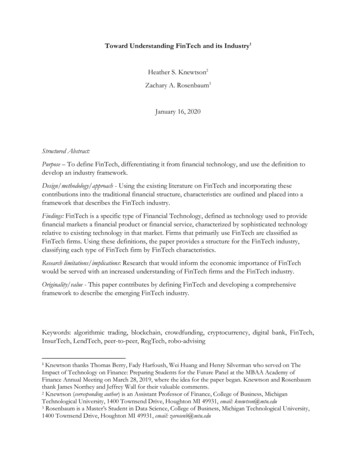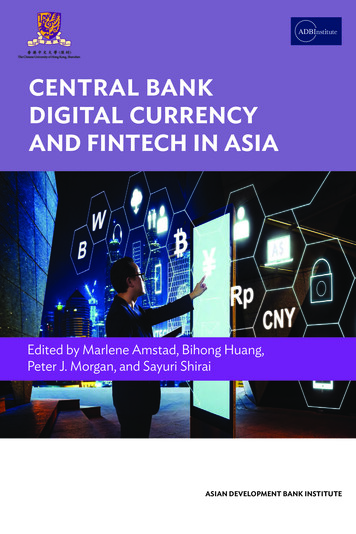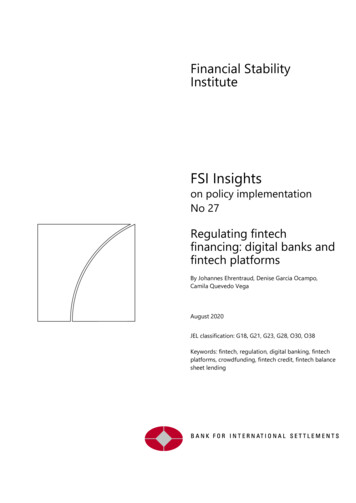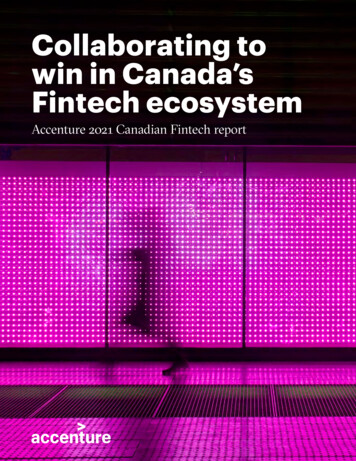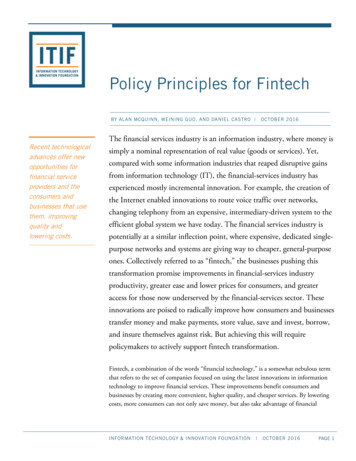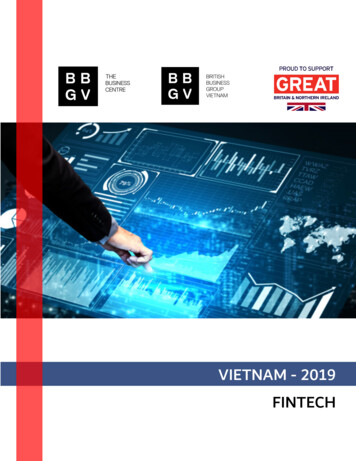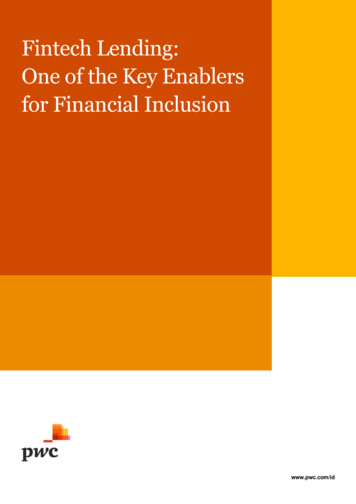
Transcription
Fintech Lending:One of the Key Enablersfor Financial Inclusionwww.pwc.com/id
Indonesia’s demographic segments have a uniqueeconomic potential that comes with certain risksThe large proportion of Indonesia’s workingage population has the potential to boosteconomic growth. However, even at thepeak of its working age population,Indonesia still trails behind in terms of itsown potential to raise GDP per capitaAs the world’s fourth most populous country,and with more than 60 percent of its people ofworking age (Fig.1), Indonesia has uniqueeconomic potential. This working agepopulation has the potential to driveIndonesia’s Gross Domestic Product (“GDP”)Fig.1 Population based on ageIn percentage, 2019F – 2031Fthrough consumer spending and localproduction capability, if it is fully utilised.However, according to the InternationalMonetary Fund, Indonesia is projected to onlyproduce 32 percent of the United States’ GDPper capita (during its own peak working agepopulation) even at the peak working agepopulation in 2031 (Fig.2)1. This projectionshows that unique opportunity comes with thepotential risk of having a large working agepopulation deteriorating in productivity, withouthaving fully utilised its potential to boosteconomic growth.Fig.2 Per capita income level at the peak of workingage population share1In percentage of USA GDP per Capita (PPP based)Source: IMF; PwC Analysis.Note: Figures are reported according to the peak or projectedpeak of working age population years 1992 – 2056 and does notconsider improved financial inclusion rate in the GDP Per capitacalculation.Source: Central Bureau of Statistics; PwC Analysis“Indonesia: Selected Issues” Report, InternationalMonetary Fund (2018)1
One of the key elements that can boosteconomic growth effectively is providingaccess to financial services, and consequentlyutilising credit to boost spending andaccelerate production capability. However,Indonesia had a very low loan disbursementper GDP compared to other countries in 2017(Fig. 3), indicating that its financing capacity isnot yet fully utilised. In addition, acrossIndonesia, around 73% of middle to lowerindividuals2 and 74% of micro, small andmedium enterprises (“MSMEs”) still do nothave access to financing (Fig. 4) (financinggap for MSMEs account for approximatelyUSD 165.8 billion per year in 20173). Withoutbetter access to financing, instead of becomingthe engine of economic growth, the majority ofindividuals and MSMEs in Indonesia will beexcluded the growth and its many benefits.Fig. 1 Household Debt per GDPFig. 4 Access to Credit for Working Age Middle toLower Individuals and MSMEsBy Percentage, 2017By Percentage, 2018Source: International Monetary Fund; Asian Development Bank; PwC Analysis.Notes:Based on individuals aged 15 , see Appendix for definition of “Access to Credit” and “No Access to Credit”Based on 2017 data from Ministry of Cooperative and MSME3) Based on the statistics for MSME credit accounts for August 2017, Central Bank of Indonesia1)2)Conventional lending providers see this as anopportunity to tap into; however, they havecertain limitations (Fig. 5) that opens up roomfor innovation via financial technology (Fintech)to provide alternative solutions. FintechLending players match different risk appetitesfor lenders with different risk levels ofborrowers to fulfil the borrowing needs of thebroader segments of Indonesian society.Fintech Lending players have leveraged acombination of different business models,technology and innovative approaches,enabling them to achieve wider coverage23Referring to middle to lower social economic status (SES)MSME Report, International Finance Corporation (2017)
within remote areas, and solve infrastructureand risk management challenges that aretypically faced by banks in serving untappedsegments (Fig.5).Within the Fintech Lending industry, differentbusiness models have emerged (e.g., peer-topeer vs. institutional-to-peer, productive vsconsumptive loan providers).Some players even leverage innovativeapproaches, such as various Online to Offline(“O2O”) channels, to provide an alternativemeans in driving loan origination anddisbursements for non-mobile phone users.Fig.5 How Fintech Lending overcomes conventional lending providers’ limitationsSource: Financial Services Authority (OJK); PwC Analysis.There are various methods of loandisbursement and repayment within theFintech Lending business model, whichcreates the formation of multiple accesschannels for consumers. The typicalmarketplace model (Fig 6) can be broken downinto four steps. Firstly, you have lenders(whether individuals or institutional), who haveexcess capital and are willing to lend thesecapital for a certain level of return. Then thereare borrowers (whether individuals orproductive MSMEs), who have submitted theirloan request to the P2P Lending platform. TheP2P Lending Platform then acts as themarketplace “connector” that matchesborrowers’ loan needs to the financing capitalprovided by lenders. Besides acting as a“connector”, the P2P Platform may also utilisethe services of a credit bureau to analyse apotential borrowers’ credit history and assessthe risk of the loan.During the loan disbursement phase, individualborrowers can either take a full cashdisbursement or receive disbursement ininstalments. Enterprises have the option of acash disbursement or a non-cashdisbursement that, for example, could be rawmaterials needed for their businesses. The
fourth step, the repayment and withdrawalchannel, has both online (e-commerce or banktransfer) and offline (retail store) options.Through the online-to-offline channel, FintechLending is able to obtain wider coverage.Fig. 6 Typical Marketplace Model of Fintech LendingSource: PwC Analysis.As shown in Fig.6, the sustainability of any Fintech Lending players will depend greatly on beingable to satisfy two different customers: borrowers and lenders. By doing so, it can create an endto-end impact covering all market segments in Indonesia (Fig. 7).Fintech Lending is tapping into markets throughout the end-to-end economic value chain,specifically those that are still underserved by conventional financial institutions. As a raw materialprovider, Sayfudin, a farmer, says Fintech has helped him to expand his land holdings and obtainfarming training. Within the production sector, Ratna, who weaves and sells doormats, was ableto get working capital to start her business. Bayu, a university student, is an example of a FintechLending end user who was able to receive help in paying his university tuition fees and finallyearn his degree.
Fig. 7 Impacts of Fintech LendingBayu (Student)Ratna (Doormat Craftsman)Sayfudin (Edamame Farmer)Source: PwC Analysis.
Indonesia’s Fintech Lendingdifferent regulatory approachIndonesia has huge market potential in FintechLending, and some are looking at China’sFintech boom beginning in 2013 as abenchmark. Indonesia has benefitted fromanalysing China’s initial mistakes, which hasshaped the Government to take a moresupportive regulatory approach. China’smarket and business model targets thehundreds of millions of lower-incomeindividuals who do not have credit cards, whichresulted in a majority of Chinese P2P playersoffering short-term consumer loans. Indonesia,for its part, is targeting both underservedecosystem:individuals and MSMEs, which provides abalanced mix.China’s regulation only started to implementincreasingly strict regulations (with stringentcompliance procedures) in 2017 to eliminatethe increasingly large number of “delinquent”P2P Lending platforms, which resulted in anegative effect of a market fall-out. From thestart, Indonesia’s regulatory framework hastaken a principle-based and collaborativeapproach, which aims to control the marketand minimize the proliferation of “delinquent”platforms early on.Fig. 8 Milestones in Indonesia’s Fintech LendingSource: Financial Services Authority (OJK); PwC Analysis.A
PwC defines the industry evolution of Fintech Lending based on its regulatory involvement.Through the establishment of AFPI, Indonesia is currently entering the “Third Wave,” (Fig. 8 andFig. 9) where players have a clearer code of conduct, the government has a better view forlicensing legal players, and investors also have higher confidence to invest in or acquire a FintechLending companies. This differs from the previous waves where the “First Wave” marked theunregulated era where players were testing out business models; and the “Second Wave”, whichmarked the involvement of OJK to ensure customer protection by establishing distinction betweenlegal and illegal Fintech Lending players.Fig. 9 Fintech Lending Industry “Waves”Source: Financial Services Authority (OJK); PwC Analysis.
Going forward, the capability to understand and cater the perspectives and needs from variousstakeholders within the ecosystem will determine the next evolution of the industry (Fig. 10).Fig. 10 Voices of Fintech Lending’s StakeholdersSource: PwC Analysis.
About the ReportWith the rapid growth of the Fintech Lending industry, there are some market and regulatorychallenges that require stakeholders to work together to ensure its sustainability. This is why PwC’s2019 Fintech Lending report is focused on the market potential of Fintech Lending and perspectivesof Customers, Players, Investors and Government.In PwC’s 2019 Fintech Lending report, our most comprehensive to date, we asked over 2,800Fintech Lending customers (including borrowers and lenders) across Indonesia about theirbehaviour and expectations. Their answers can help players to be more informed on how to positionthemselves for the future, while at the same time, help government to assess the impact of FintechLending to facilitate financial inclusion in Indonesia.Aside from customers, players have a major stake in determining the future of the Fintech Lendingindustry. First, the number of registered players under OJK and new entrants queuing to beregistered has never been higher. To compete in today’s Fintech Lending landscape, new entrantsdo not require as much capital as other financial institutions. For instance, the minimum capitalrequirement to register as a Fintech Lending player is IDR 2.5 billion, compared to a multi-financecompany that requires IDR 100 billion. Not only do pure play Fintech Lending players rise up, butmulti-finance and technology companies (e.g. e-commerce, ride-hailing companies, online travelagencies) have started leveraging their networks and capabilities to tap into the online lendinglandscape. Second, Indonesians’ limited financial literacy poses a significant challenge to raisingawareness and increasing the conversion of untapped market segments into Fintech Lending.In terms of investors, managing financial returns or realising strategic objectives is critical. Thisforces them to make smarter investments. Therefore, there are many factors going into investmentdecisions, ranging from players’ value propositions to expected industry growth to the expected endgame of Fintech Lending players.The four “Voices of The Stakeholders” that will be described in PwC’s 2019 Fintech Lending reportwill unveil a range of perspectives including current and future expectations, challenges andopportunities, and the impact of Fintech Lending.This content is for general information purposes only, and should not be used as a substitute forconsultation with professional advisors. 2019 PwC. All rights reserved. PwC refers to the PwC network and/or one or more of its memberfirms, each of which is a separate legal entity. Please see http://www.pwc.com/structure for furtherdetails.
Fig.5 How Fintech Lending overcomes conventional lending providers' limitations Source: Financial Services Authority (OJK); PwC Analysis. There are various methods of loan disbursement and repayment within the Fintech Lending business model, which creates the formation of multiple access channels for consumers. The typical


